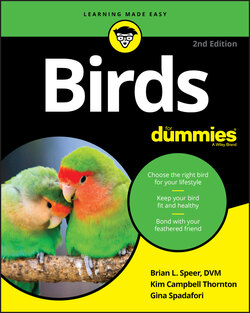Читать книгу Birds For Dummies - Gina Spadafori - Страница 60
Chickens, ducks, geese, pigeons, peafowl, and turkeys
ОглавлениеChickens’ popularity as backyard birds has risen astronomically in the past two decades. Although many people may raise their eyebrows at the idea of a pet chicken (like the one in Figure 2-8), common (and not-so-common) barnyard fowl can be absolutely charming, ideal for the person with a bit of land. They’re cuddly and trainable — we’re not kidding! — and come in a variety of colors and sizes. They’re often flamboyantly feathered, right down to their feet. Many chicken breeds are docile, confident, and friendly. Bonus: Eggs for breakfast!
Photograph courtesy of D. Davidson Harpur
FIGURE 2-8: Spicoli, who resembles the avian version of a Dalmatian, is a silver-spangled Hamburg.
Chickens have been domesticated for more than 7,000 years, but only recently have they become widely popular as pets. Some people keep exotic and heritage breeds of chickens for their beautiful or unusual appearance (the Appenzeller Spitzhauben is described as resembling a Dalmatian with a mohawk), while others consider such factors as temperament, adaptability to cold or hot weather, small size (the better to keep one in a condo), and laying ability.
Many municipalities do not permit the keeping of roosters (adult male chickens) because they can be extremely noisy, especially early in the morning or any time they feel the need to declare their territory. They may also be aggressive toward people or other animals. To keep peace in your neighborhood, if you buy an assortment of unsexed chicks, be prepared to find a new home for any that turn out to be roosters. If you don’t want to run this risk, consider purchasing chicks from a sex-linked breed, meaning males and females are easily distinguished at hatch.
Prices can range from $5 for a day-old unsexed (meaning you may get a rooster) buff Orpington chick to $99 for a day-old unsexed Deathlayer chick, known for a luxuriant tail and black feathers glistening with iridescent green and purple. Chickens are social, so you’ll want to have two or more. Don’t forget to factor in the cost of a coop, nest boxes, and other equipment.
Like chickens, ducks come in some striking varieties and can provide you with delicious fresh eggs! Geese can be outstanding watch-birds, and even turkeys can be beautiful and affectionate. Peafowl, the males at least, are gorgeous, but the loud screams of the males are not for everyone and may not contribute to good relationships with your neighbors.
Although none of these birds is known for their intelligence, many are kept and enjoyed as companion animals. Brian works with many clients and rescue groups with pet chickens, ducks, and geese who come when they’re called and seek out their owners for affection. On his own happy “birdstead,” Brian has several geese, ducks, and pigeons, as well as macaws.
Chickens, ducks, and geese can live comfortably on a large suburban lot (if your community’s zoning allows it, of course), but the same can’t be said of the glorious peacock. Prized for their fantastic plumage, peacocks (the female is a peahen, and both are peafowl) can get you in trouble with the neighbors in short order for their amazingly high-decibel calls at night. These lovely creatures are best suited to houses on large acreages — or to places with deaf neighbors.
